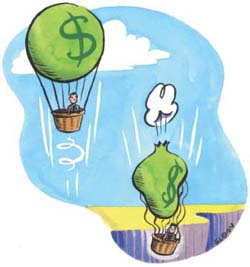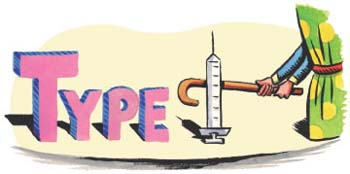 |
 |
| current issue |  |
past issues |  |
send a letter/news |  |
address update |  |
advertise |  |
about us |  |
alumni home |
by Lewis I. Rice
In this issue:
Mind the GapInjection Protection
Darth Vader, Team Leader
Mind the Gap
The have-mosts rise while the have-leasts are sinking

|
By any measure, New Hampshire is a prosperous state. It ranks seventh in the country in terms of income per person, first for its low rate of poverty and third for having the least discrepancy between households at the top and bottom of the income scale. So what's not to like?
Actually, averages and snapshots can be misleading, cautions Ross Gittell, James R. Carter Professor at the UNH Whittemore School of Business and Economics. In a recent report published by UNH's Carsey Institute, he looked at trends between 1989 and 2004, and what he found came as a surprise. Of all the regions in the country, New England exhibited the largest increase in the disparity between families at the top and bottom of the income ladder, with fewer people hanging on to that comfortable region in the middle. Although New Hampshire's gap between the have-mosts and the have-leasts is still relatively small, it has widened significantly, indicating a worrisome trend.
The good news is that New England, like New Hampshire, remains generally affluent, especially among the top quintile of households. In this group, the average inflation-adjusted household income of nearly $185,000 has increased 20 percent in the past 15 years, thanks in large part to high-tech and high-skilled jobs and business opportunities.
But the increasing divergence is not merely due to "the rich getting richer," Gittell writes. On a percentage basis, New England has led the nation in the loss of manufacturing jobs, which has taken a toll on lower- and middle-income earners. Many have been forced to take jobs that pay significantly less. In the bottom quintile, where the average household earns $12,437 a year, inflation-adjusted income dropped 5 percent over the past 15 years.
Gittell designates the middle three quintiles as "middle income," a broad definition designed to reflect the fact that in the United States, 80 percent of us identify ourselves as middle class. Traditionally, being middle class has meant having a sense of economic security, he believes, and "not struggling to pay the bills each week." When a family falls below a certain income level, it can be both economically and emotionally distressing. More members of the family have to work, and they have to work more hours. "They're struggling to make ends meet," says Gittell. "This has an effect on the whole family dynamic." The concept of the "lifetime job" has all but disappeared, he notes.
Gittell believes the widening gap can also have detrimental effects on communities. In the past, New Hampshire has had high levels of "social capital," he says. "It's harder to keep the social glue together when people start going to different stores, living in different neighborhoods, sending their children to different schools."
If the trajectory of increasing income disparity in the state continues, it could become a problem in the future, says Gittell. He recommends expanding educational and training opportunities, including "re-preparation" programs to help those who have lost their jobs. He also calls for more affordable child care, housing and public transportation.
"With a concerted effort by policymakers and residents," he writes, New England as well as New Hampshire could return to their position of providing "good economic opportunities for all citizens."
Injection Protection
Insulin in pill form could be a boon to diabetics
Before the discovery of insulin, a diagnosis of Type 1 diabetes meant certain death. A person with the disease, which is caused when the pancreas doesn't produce the hormone insulin, would face rising blood sugar levels and eventually lapse into a coma and die.
When scientists in 1922 determined that injections of insulin from a calf could treat diabetes, countless lives were saved. But that doesn't mean life is easy today for someone with Type 1 diabetes. Injections, typically three times a day, are still required to control the disease.
Recently, an insulin powder that can be inhaled has come on the market. But inhaling a powder may not appeal to all diabetics, and some may find it difficult to use.

|
Now UNH researchers are working on an easier delivery system--insulin in pill form--which could prove immensely helpful to those who have Type 1 diabetes and need to take insulin, an estimated 5 to 10 percent of the 20 million diabetics in the United States. Led by researcher Jennifer Durant and her husband, Yvon, the scientists are working to overcome major obstacles caused by the makeup of the human body.
Insulin by injection goes right into the bloodstream. But insulin taken orally travels to the stomach, where it is subjected to acid-catalyzed degradation. Since insulin is a protein, the stomach treats it like, well, chicken, and digests it. Then there's the problem of the intestine, which extracts nutrients out of food. It contains a number of pancreatic enzymes that also break down insulin.
To deliver the insulin intact, the researchers are working on a triblock polymer system called NanoCaplets(TM) to trap insulin protectively and usher it safely through the body. The approach takes advantage of the natural deterioration of the caplet to later facilitate the release of the insulin into the bloodstream. Many time-released capsules on the market today are linked to polymers.
If insulin can stay biologically active when delivered this way, the system may be useful for delivering other drugs.
Bentley Pharmaceuticals of Exeter, N.H., is collaborating with UNH by providing funding and facilities. Early tests are encouraging, says Jennifer Durant, a research assistant professor of biochemistry and molecular biology, but several more years may be needed before the researchers know if their method will work.
"I think that we have moved beyond the 'proof of concept' stage and are looking at ways to optimize the system and tease apart the mechanistic pathway of delivery," says Durant. "This is an important step."
Darth Vader, Team Leader
A happy boss is not always an effective boss
People who go to work when they're sick can spread their germs to their colleagues. But that's not the only thing that's contagious in the workplace.
As Richard Saavedra's research shows, a bad mood, like a bad cold, can be infectious--particularly when you're in charge. The associate professor of organizational behavior cowrote a paper titled "The Contagious Leader," which argues that "the moods of leaders have important consequences in self-managing groups."
Saavedra oversaw an experiment that asked groups to assemble a tent. After manipulating the mood of leaders with gloomy or humorous video footage, researchers found that group members mirrored their leaders' moods.
And those moods had consequences for the task at hand: Group members made a greater effort for leaders in a bad mood, blaming the leader's negative response on lack of progress on their project. Conversely, leaders inspired greater coordination of the team with a positive mood, which served as an invitation to be agreeable, Saavedra says. Thus, he maintains, "It would be beneficial for leaders to learn how to regulate their experiences and displays of mood to subordinates to attain desired outcomes."

|
The experiment only tested mood contagion from leader to subordinate. Saavedra acknowledges the possibility that moods can also flow in the other direction. Indeed, he notes his students' moods can influence his own behavior in the classroom. But he argues that workers look to a leader for signals, which are more likely to affect their emotions.
In reality, Saavedra says, most people probably don't think about how their moods affect others in the workplace. "I don't know if folks in the world of business understand how important it is to set the stage for the team's own sake," he says.
As an example, Saavedra cites the experience of Tom Sy, a coauthor and former graduate student who served in the military's special forces. Sy described a sergeant who told jokes as a way to calm soldiers preparing for combat. But the jokes proved to be a distraction that took away the soldiers' internal focus.
That's why if you're a manager in a beleaguered company, it's not a time for levity, says Saavedra, who has a doctorate in organizational psychology. It is time to acknowledge the difficulties and express confidence in overcoming them. It may also be a time to strategically project a bad mood, which can offer a powerful motivator for change, he says.
"There are going to be some situations where you might want to take a team to task for something," he says. "In those situations, the team tries to develop a way to handle that, and they have that forever in their repertoire."
Saavedra cautions that frequent bad moods can backfire for a leader, leading to lack of cohesion and satisfaction in a group. People are typically in a positive mood, he says, and that's generally a good thing. But for managers, he adds, "I think the darker side remains to be explored." ~
blog comments powered by Disqus
